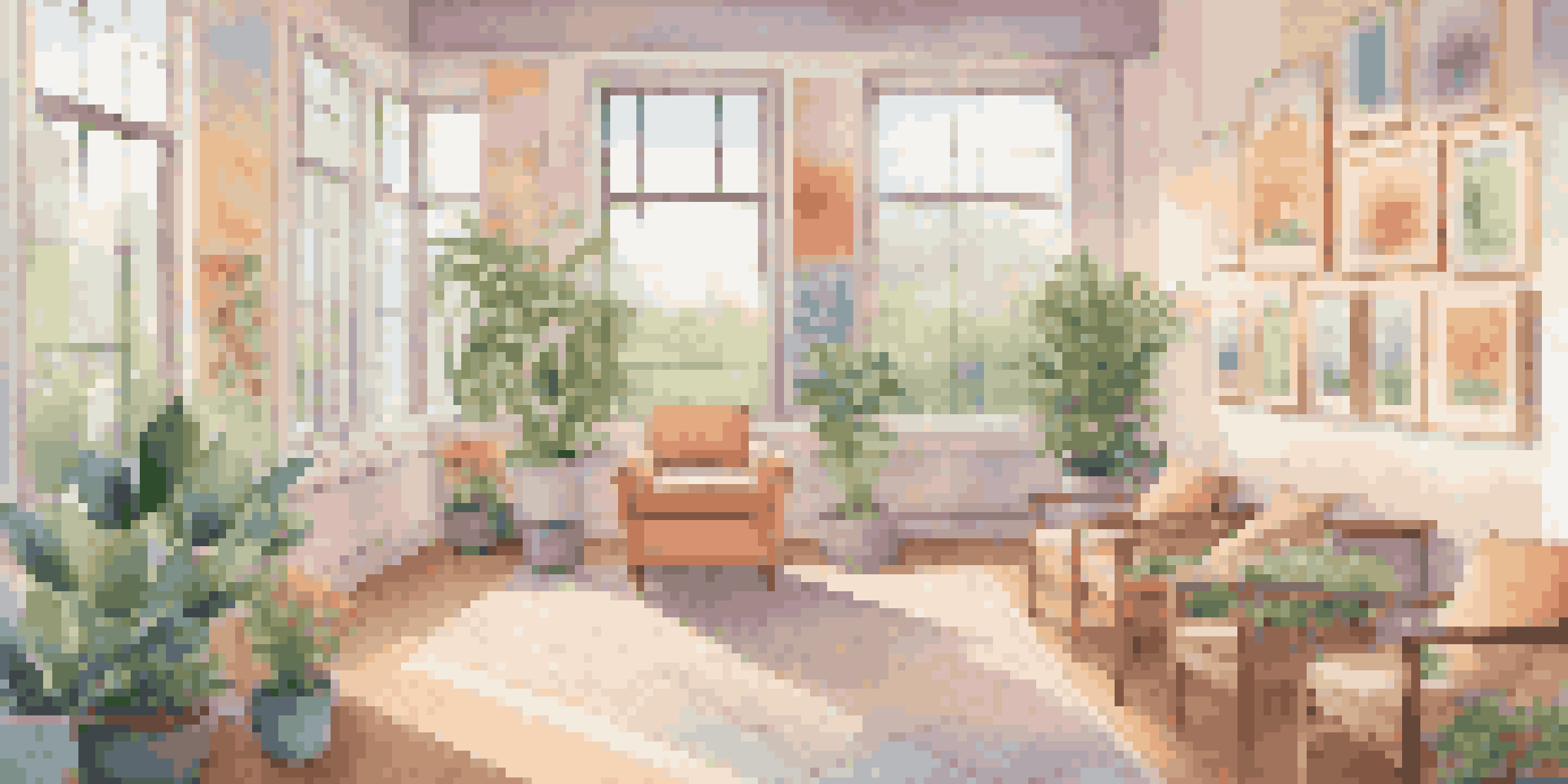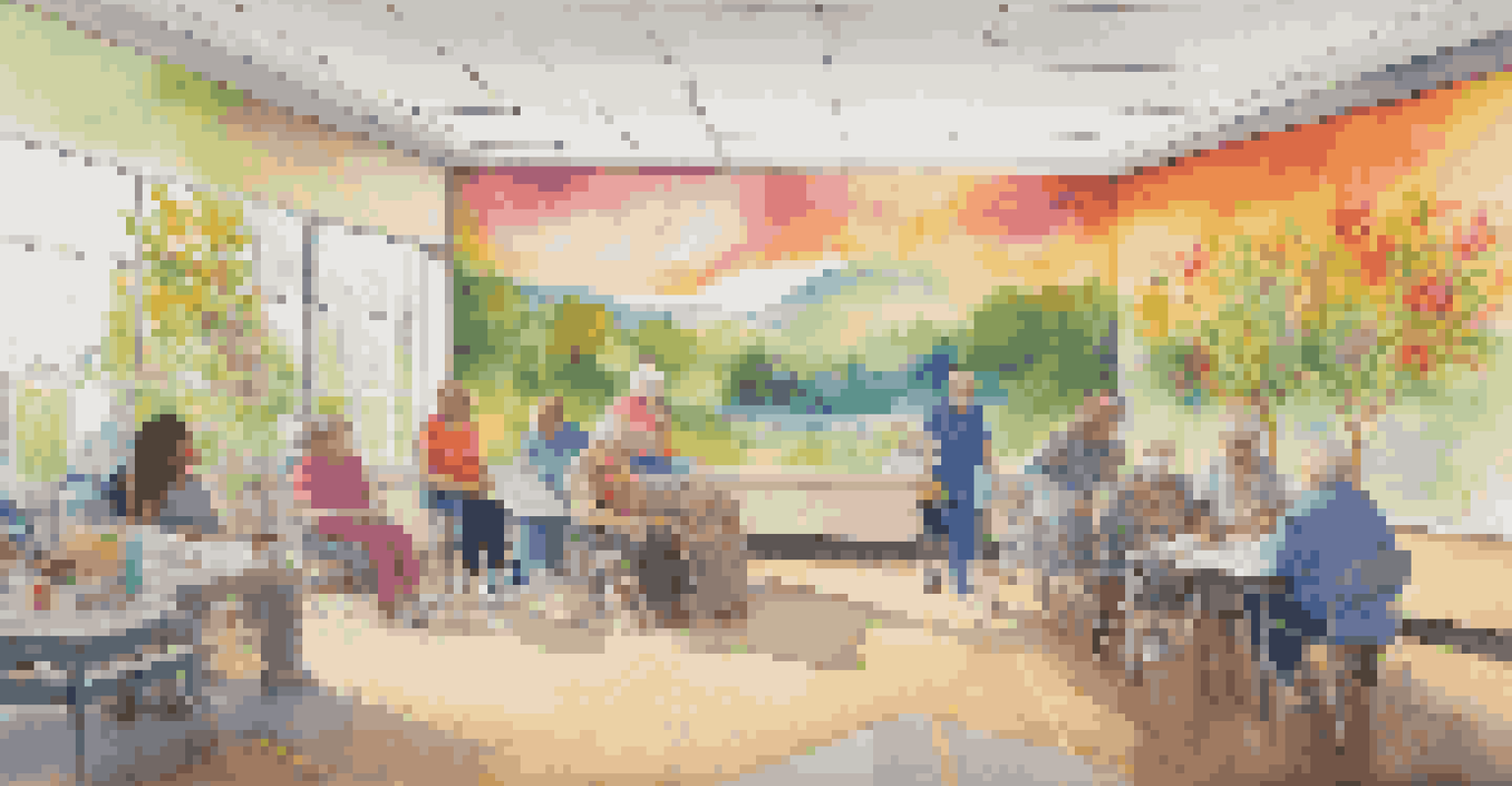The Benefits of Art in End-of-Life Care Environments

Art as a Tool for Emotional Expression in Care Settings
Art provides a powerful medium for patients to express their feelings and emotions, especially during the end-of-life stages. In an environment where words can often fail, painting, drawing, or even music can offer a voice to those who might feel silenced by their circumstances. Engaging in creative expression allows individuals to process complex emotions like fear, sadness, and hope in a safe space.
Art enables us to find ourselves and lose ourselves at the same time.
Moreover, the act of creating art can serve as a therapeutic outlet, providing a sense of relief and comfort. Patients often find that focusing on the creative process allows them to momentarily escape their realities and immerse themselves in something beautiful. This shift in focus can be incredibly healing, fostering a sense of peace in what can be a tumultuous time.
Additionally, sharing artwork with loved ones can strengthen connections and facilitate meaningful conversations. Families can engage in discussions about the art, creating opportunities for reflection and sharing memories, which can be incredibly comforting as they navigate the emotional landscape of end-of-life care.
Enhancing Quality of Life Through Art Therapy
Art therapy has been recognized as an effective approach to enhance the quality of life for patients in end-of-life care. By working with a trained art therapist, individuals can explore their thoughts and feelings about their life and impending death through creative activities. This personalized guidance ensures that the art-making process is both meaningful and therapeutic.

Research has shown that art therapy can lead to reduced anxiety and improved mood, which is crucial in the context of palliative care. Patients who engage in artistic activities often report feeling more relaxed and less distressed, making their experience more dignified. The freedom to create without judgment fosters a nurturing environment that promotes emotional healing.
Art as Emotional Expression
Art provides a profound way for patients to express complex emotions during end-of-life care, facilitating healing and connection.
Furthermore, art therapy sessions can be tailored to fit the needs and preferences of individual patients. Whether it’s making clay sculptures, painting, or even simple doodling, the adaptability of art therapy ensures that it resonates with diverse patients, enhancing their overall experience and well-being.
Creating a Calming Environment with Visual Arts
The presence of artwork in care environments can significantly impact the atmosphere, fostering a calming and comforting space. Beautiful paintings, soothing colors, and inspiring sculptures can evoke feelings of tranquility and hope, making the environment more welcoming for patients and families alike. This visual stimulation can also help distract from pain and discomfort.
Music can change the world because it can change people.
Incorporating art into physical spaces can enhance the overall aesthetic and promote a sense of peace. For example, murals or nature-themed artwork can create a serene ambiance that encourages relaxation and reflection. This transformation of care environments not only benefits patients but also supports families and staff in navigating the emotional weight of end-of-life care.
Moreover, art installations can serve as conversation starters, bridging connections among patients, families, and caregivers. Shared experiences and discussions about the artwork can foster a sense of community and support, essential elements in coping with the challenges of end-of-life situations.
Music as a Companion in End-of-Life Care
Music, much like visual art, plays an integral role in enhancing the experience of end-of-life care. It can evoke emotions, trigger memories, and create a comforting atmosphere, making it a powerful tool for emotional support. Whether through live performances or curated playlists, music can deeply resonate with patients, offering both solace and connection.
Research indicates that music therapy can reduce pain perception and anxiety, making it an invaluable resource in palliative care. The soothing melodies can help create a calming environment, easing the emotional and physical stress that often accompanies the end of life. Patients may find comfort in familiar tunes that remind them of cherished moments, promoting a sense of peace.
Art Therapy Enhances Well-Being
Engaging in art therapy has been shown to reduce anxiety and improve mood, significantly enhancing the quality of life for patients.
Furthermore, participating in music activities, such as singing or playing instruments, can foster a sense of agency and joy. Engaging with music can bring patients together with their families and caregivers, creating shared experiences that strengthen relationships during this poignant time.
Art as a Means of Legacy and Remembrance
Creating art can serve as a powerful way for patients to leave behind a legacy for their loved ones. Whether it’s through painting, writing, or crafting, the act of creating something tangible can provide a sense of purpose and fulfillment. This desire to create a lasting memory can be incredibly meaningful for both patients and their families.
Artistic expressions can encapsulate a patient’s life story, reflecting their experiences, beliefs, and values. Families often cherish these pieces as beautiful reminders of their loved ones, facilitating conversations about memories and shared moments. This not only honors the patient’s life but also helps families navigate their grief in a constructive way.
Moreover, collaborative art projects can involve family members and caregivers, creating shared experiences that strengthen bonds. Working together on a piece of art can foster connection and understanding, encouraging open dialogue about feelings and memories, which are essential for healing.
Supporting Caregivers Through Artistic Engagement
Caregivers play a crucial role in end-of-life care, and their emotional well-being is just as important as that of the patients. Engaging with art can provide caregivers with an essential outlet for their own feelings of stress and grief. Participating in creative activities can help them process their emotions, reducing the risk of burnout and compassion fatigue.
Art can also serve as a bonding experience between caregivers and patients, enhancing the quality of care provided. When caregivers engage in artistic activities with patients, it can strengthen their relationships, fostering trust and understanding. This shared experience can lead to more compassionate care, benefiting both parties in the process.
Creating Lasting Legacies
Through artistic expression, patients can leave behind meaningful legacies that honor their lives and facilitate healing for their families.
Additionally, art programs tailored for caregivers can provide them with a supportive community where they can share experiences and challenges. These programs can help cultivate resilience and emotional strength, ensuring that caregivers are equipped to provide the best support possible during such a challenging time.
The Lasting Impact of Art in End-of-Life Care
The integration of art into end-of-life care environments creates a holistic approach that not only addresses physical needs but also nurtures emotional and psychological well-being. The benefits of engaging with art extend beyond the immediate experience, leaving a lasting impact on patients, families, and caregivers alike. This multifaceted approach enriches the entire caregiving process.
As we explore the role of creativity in these sensitive environments, it becomes clear that art is not merely a luxury, but a necessity. It enhances the quality of life, fosters connection, and provides a means for expression and remembrance. By prioritizing artistic engagement, we can transform end-of-life care into a more compassionate and meaningful experience.

Ultimately, embracing the benefits of art in end-of-life care can lead to a more dignified and fulfilling journey for everyone involved. It encourages us to celebrate life, even in its final stages, reminding us that creativity can bring light to the darkest of times.